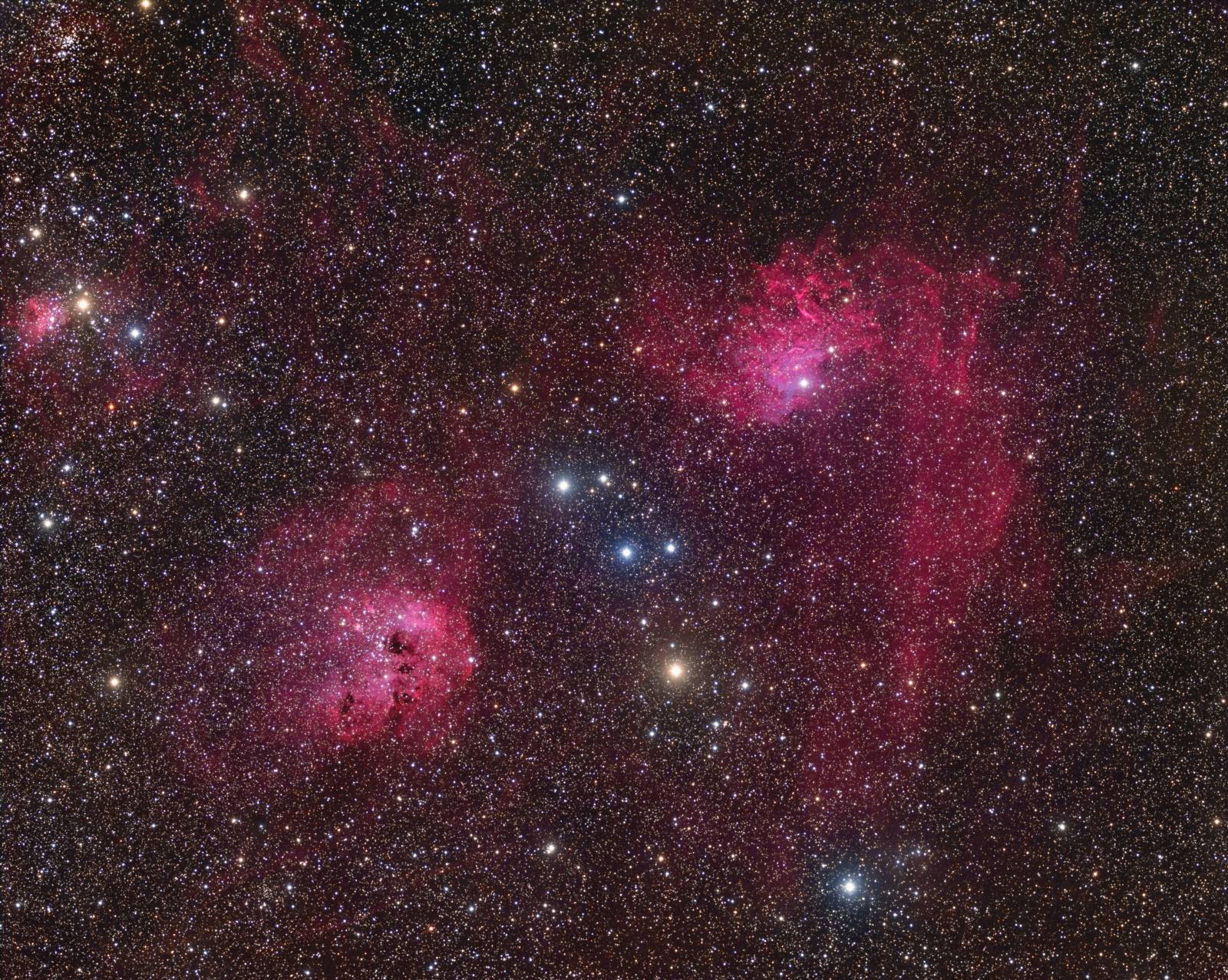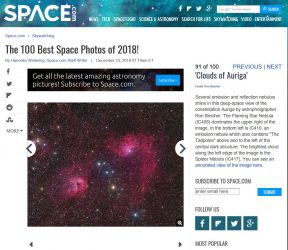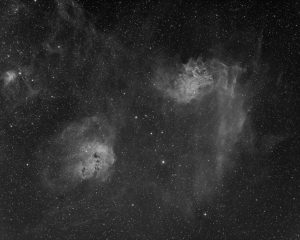Clouds of Auriga – Wide Field
 Click image for full size version
Click image for full size version
February 18, 2018
 This wide-field image shows the extended clouds of nebulosity in Auriga, the Charioteer. I’ve imaged several of the objects in this image at higher magnification. See the annotated image for more information:
This wide-field image shows the extended clouds of nebulosity in Auriga, the Charioteer. I’ve imaged several of the objects in this image at higher magnification. See the annotated image for more information:
- The Flaming Star Nebula (IC405) dominates the upper right of the image. It has emission and reflection nebula components and lies about 1,500 light years away and 5 light years across. The brightest star in the nebula, AE Auriga, is causing the glow. My previous higher resolution image of this object is here.
- At lower left is IC410, which also contains “The Tadpoles” above and to the left of the central dark structure. IC 410 is a little further away than IC405, at close to 20,000 light years. My higher resolution image of this object is here. It was made in collaboration with my good friend Warren Keller.
- The Spider Nebula, IC417, is the bright nebula along the left edge, above centre. I imaged this at a higher resolution a few years ago.
- Open cluster NGC 1907 is in the upper left corner.
 This image is dominated by clouds made mostly of hydrogen atoms that release energy as red light. I prepared a black and white version using a Ha filter that allows only this specific wavelength through. It shows more subtle brightness differences and smaller stars. Click on the thumbnail to see it full size.
This image is dominated by clouds made mostly of hydrogen atoms that release energy as red light. I prepared a black and white version using a Ha filter that allows only this specific wavelength through. It shows more subtle brightness differences and smaller stars. Click on the thumbnail to see it full size.
Tekkies:
Moravian G3-16200 EC camera (on loan from O’Telescope), Optolong Ha, R, G and B filters, Takahashi FSQ-106 ED IV at f/3.6, Paramount MX. QHY5 guide camera on 175mm guide scope. Acquisition with the SkyX, focused with FocusMax, scripted with CCD Commander. All pre-processing and processing in PixInsight. Acquired from my SkyShed in Guelph. Moderate moonlight for Ha, no moonlight for RGB, average transparency and seeing.
14x10m R, 13x10m G, 12x10m B and 29x10m Ha unbinned frames (total=11hr30m).
RGB:
Creation and cleanup: The BatchPreProcessing script was used to perform calibration, cosmetic correction and registration of all frames. LocalNormalization was applied, and ImageIntegration and DrizzleIntegration were used to make the Ha, R, G and B masters using Local Normalization for scaling. The R, G, B masters were processed with DynamicBackgroundExtraction. The R, G and B were combined to make an RGB image which was processed with PhotometricColorCalibration.
Linear Noise Reduction: MultiscaleLinearTransform was used to reduce noise in the RGB image. Layer settings for threshold and strength: Layer 1: 3.0 0.8 Layer 2: 2.5, 0.7 Layer 3: 2., 0.6 Layer 4: 1.0, 0.2 Layer 5: 0.5, 0.1.
Stretching: Two low-strength passes of ArcsinhStretch were used to slightly stretch the image, setting the black point so as to avoid any clipping. HistogramTransformation was applied to make a pleasing, bright image. Curve was applied to boost contrast and saturation.
Synthetic Luminance:
Creation and cleanup of SynthL: The R, G and B channel masters were integrated (average, noise weighted, no rejection) using ImageIntegration to create the SynthL.
Deconvolution: A star mask was made to use as a Local Deringing Support image. A copy of the image was stretched to use as a range mask. Deconvolution was applied (50 iterations, regularized Richardson-Lucy, external PSF made using DynamicPSF tool with about 30 stars).
Linear Noise Reduction: MultiscaleLinearTransform was used to reduce noise in the background areas of the SynthL. Layer settings for threshold and strength: Layer 1: 3.0 0.9 Layer 2: 2.0, 0.75 Layer 3: 1.0, 0.6 Layer 4: 0.5, 0.2.
Stretching: HistogramTransformation was applied to the SynthL to make a pleasing, bright image.
Noise Reduction and Re-Stretch: TGVDenoise was applied in Lab mode with 300 iterations with a range mask applied to protect high signal areas. This was followed by a HistogramTransformation to raise the black point (but with no clipping).
H-alpha:
Deconvolution: A star mask was made to use as a Local Deringing Support image. A copy of the image was stretched to use as a range mask. Deconvolution was applied (50 iterations, regularized Richardson-Lucy, external PSF made using DynamicPSF tool with about 20 stars).
Linear Noise Reduction: MultiscaleLinearTransform was used to reduce noise in the background areas of the Ha image. Layer settings for threshold and strength: Layer 1: 3.0 0.9 Layer 2: 2.0, 0.75 Layer 3: 1.0, 0.6 Layer 4: 0.5, 0.2.
Stretching: HistogramTransformation was applied to the Ha to make a pleasing, bright image.
Noise Reduction and Re-Stretch: TGVDenoise was applied in Lab mode with 300 iterations with a range mask applied to protect high signal areas. This was followed by a HistogramTransformation to raise the black point (but with no clipping).
Combining SynthL, RGB and Ha:
SynthLRGB: The processed SynthL was applied to the RGB image using LRGBCombine.
SynthLHaRGB: PixelMath was used to add 50% Ha to the red channel and 5% Ha to the blue using a mask to protect stars and background areas free of nebulosity (identified based on the Ha image).
Additional Processing:
Shrinking the Stars: MorphologicalTransformation was used in Morphological Selection mode (Selection 0.13, strength 0.12) with a star mask to slightly reduce the size of the stars.
Dark Structures: The DarkStructureEnhance script was used (8 layers, strength 0.2) to darken dark regions in IC 410.
Sharpening: Using a mask throughout sharpening, MultiscaleLinearTransform was applied to sharpen layers 2 and 3 (bias of 0.3 and 0.1, respectively), followed by UnsharpMask (radius 2, strength 0.25). Convolution was applied with a radius of 0.5 pixels.
Final Steps: Background, nebula and star brightness, contrast and saturation were adjusted in several iterations using Curves with masks as required.The image was downsampled by a factor of 2 using IntegerResample to restore the original resolution.
Image scale is about 3.2 arcsec per pixel for this camera/telescope combination.






Leave A Comment